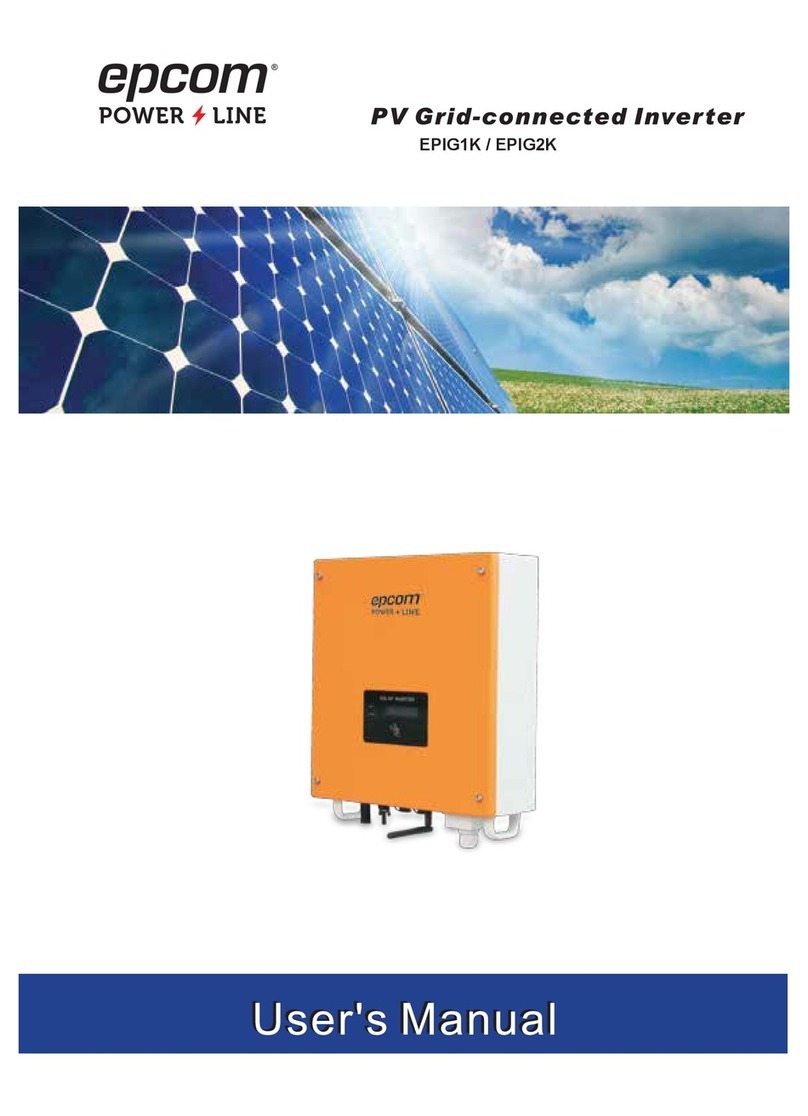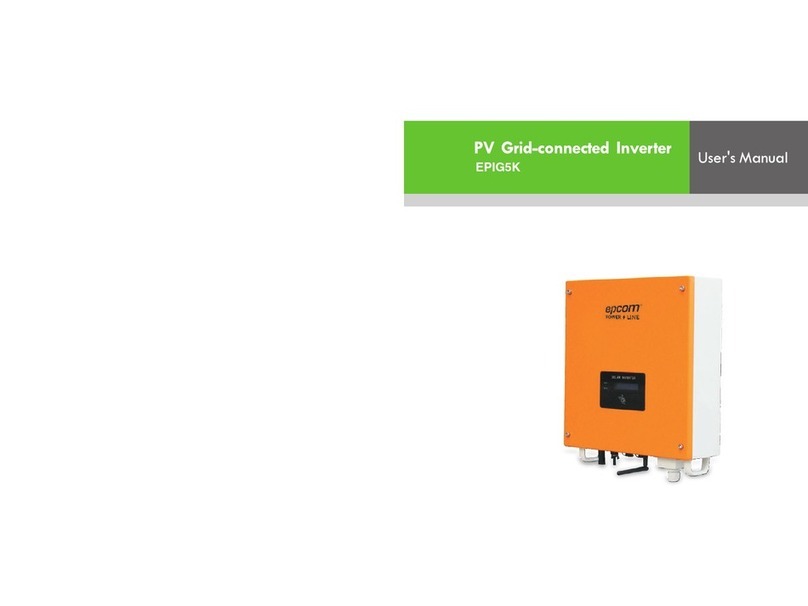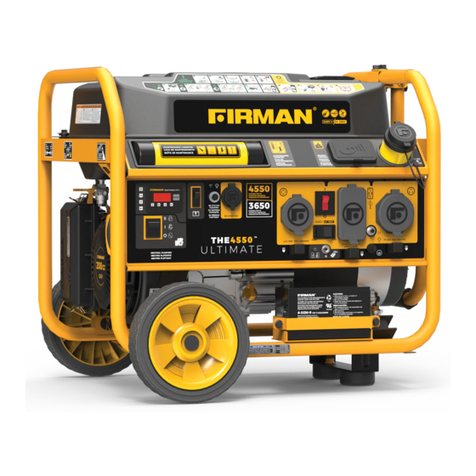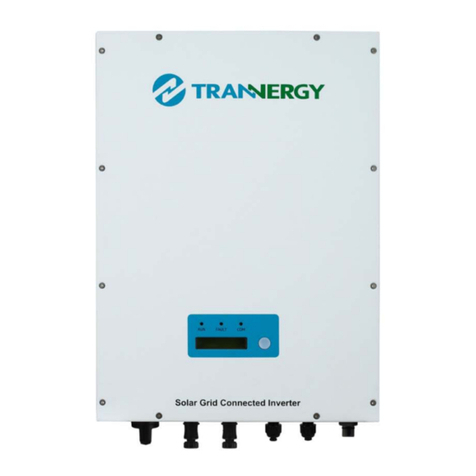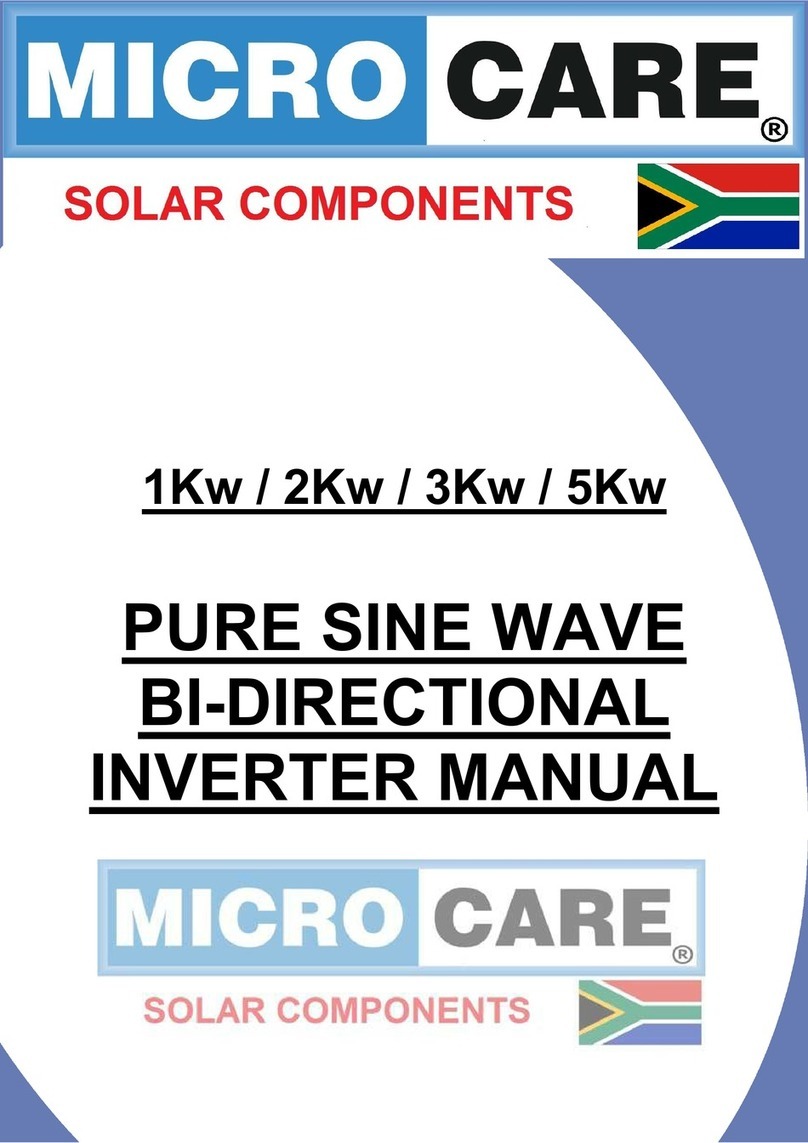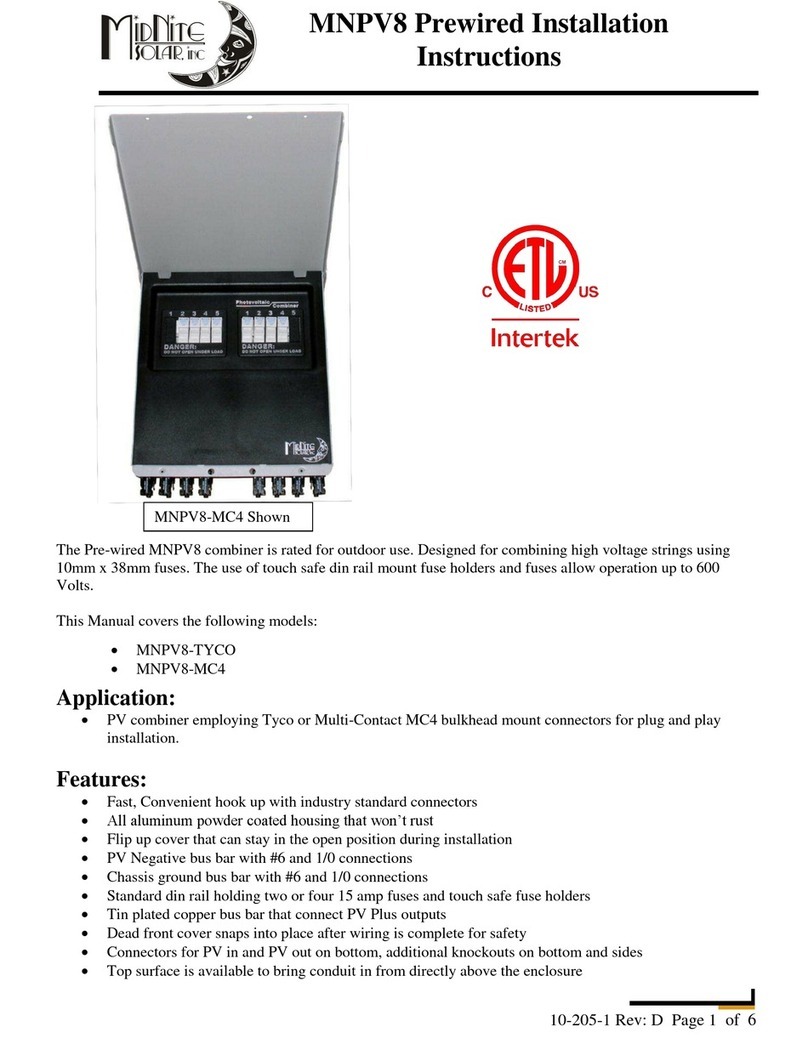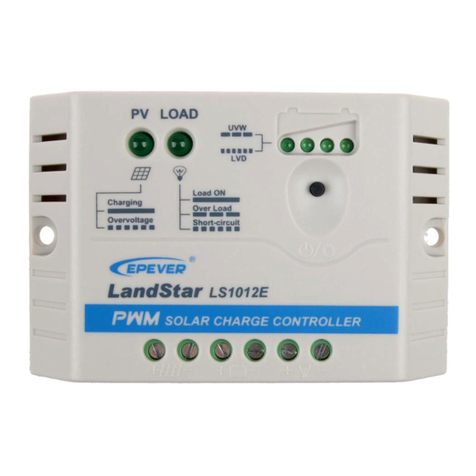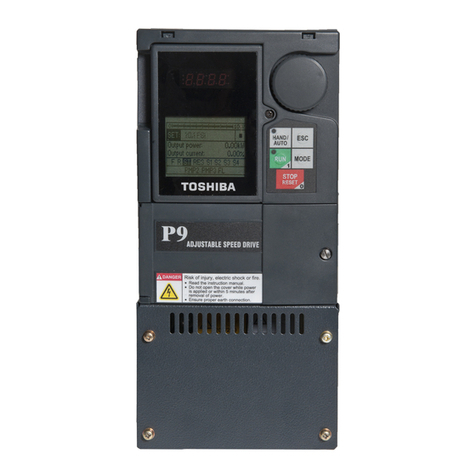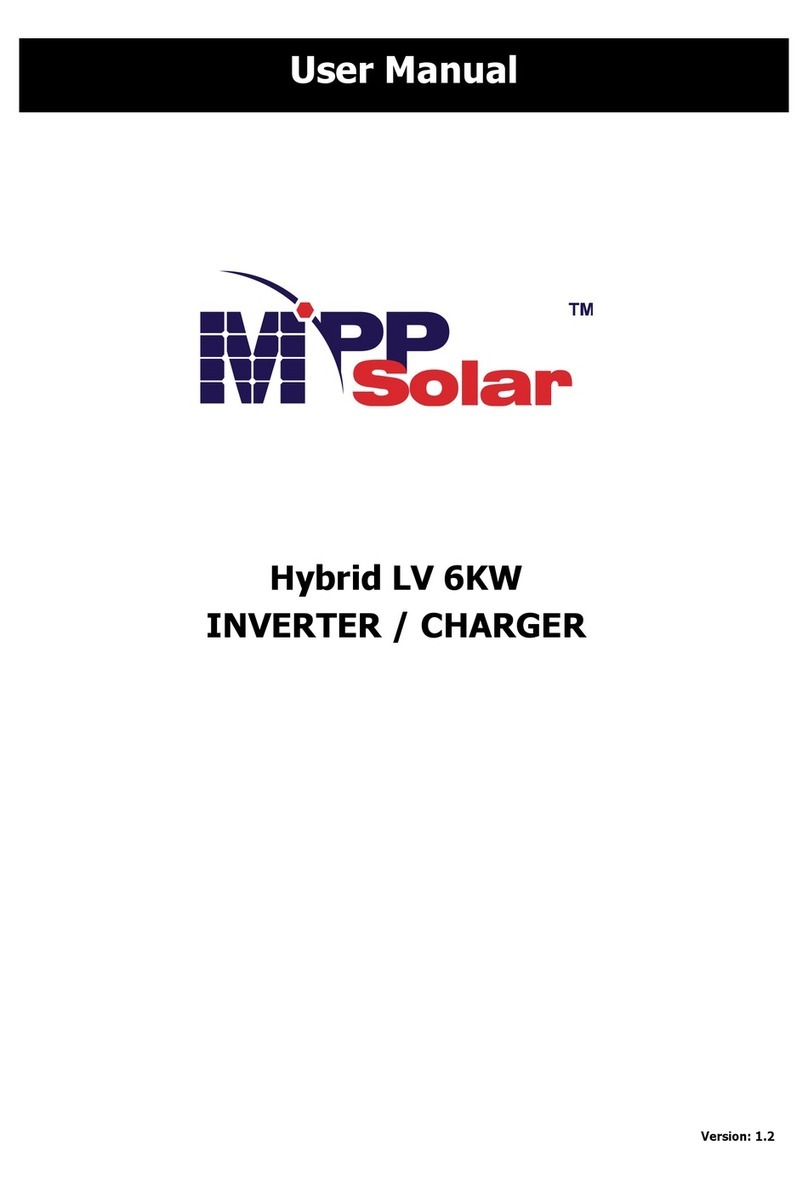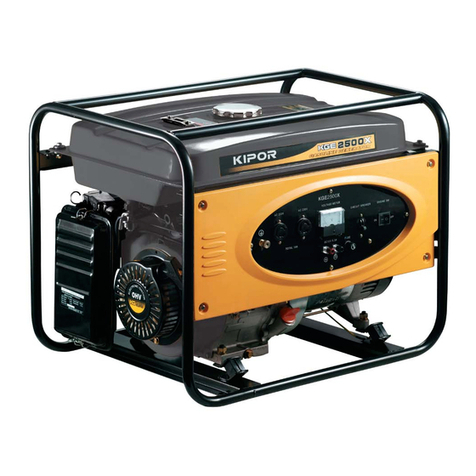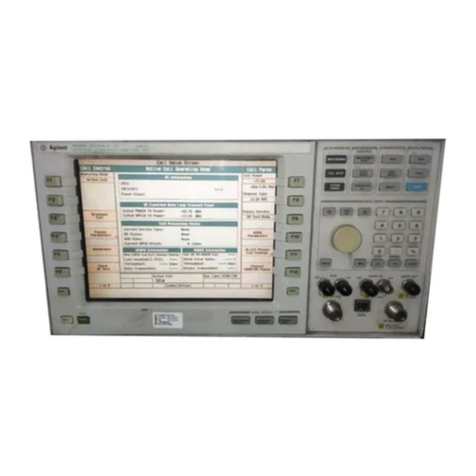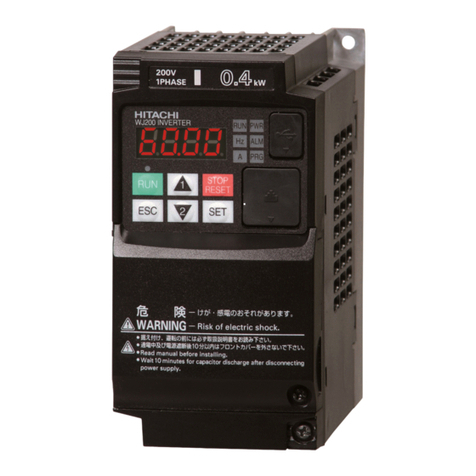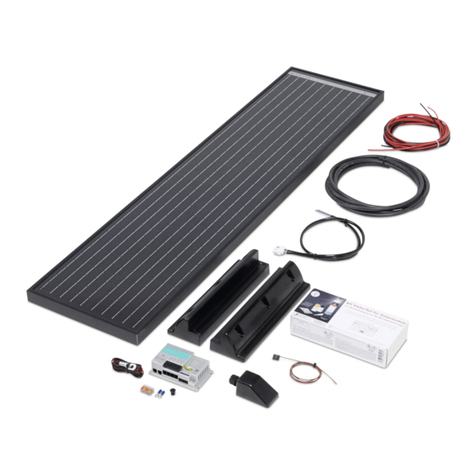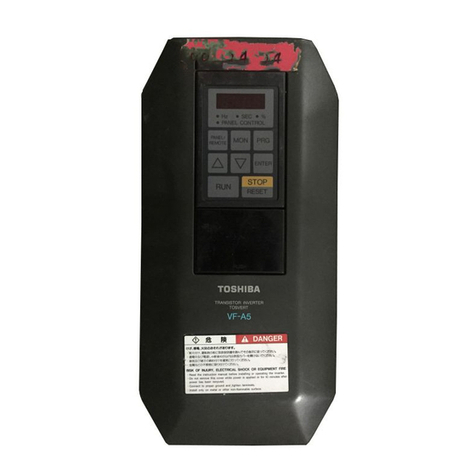Epcom EPIG7K User manual

Table of Contents
1General Information ........................................................................................................1
1.1 Safety Messages......................................................................................................1
1.2 Validity.......................................................................................................................2
1.3 Safety Precautions ...................................................................................................2
2 Product Overview............................................................................................................5
2.1 Components of PV Grid-Connected System..........................................................5
2.2 Schematic Diagram..................................................................................................6
2.3Appearance of Inverter.............................................................................................6
2.4Weights and Dimensions of Inverter........................................................................7
2.5 Specifications............................................................................................................8
3 Unpacking and Storage.................................................................................................11
3.1 Unpacking Inspection.............................................................................................11
3.2 Storage....................................................................................................................11
4Installation......................................................................................................................12
4.1 Mounting Location..................................................................................................12
4.2 Mounting the Inverter.............................................................................................13
4.2.1Clearance......................................................................................................13
4.2.2 Installation Procedure...................................................................................13
5 Electrical Connection....................................................................................................15
5.1 Safety Precautions .................................................................................................15
5.2 Electrical Connection Diagram ..............................................................................16
5.3 Cable Requirements...............................................................................................17
5.4 DC Connection........................................................................................................18
5.5AC Connection........................................................................................................20
5.6 Second Protective EarthConnection....................................................................21
5.7 Connection of Anti-Backflow Meter (Optional)......................................................
22
6 Installing the Communication Module..........................................................................24
7 Operation.......................................................................................................................26
7.1 Switching On...........................................................................................................26
7.2 Switching Off...........................................................................................................26
7.3 LED Indicator Lights...............................................................................................27
8 Monitoring......................................................................................................................28
8.1 Professional EditionApp........................................................................................28
8.1.1 Software Installation......................................................................................28
8.1.2Registration& Login......................................................................................28
8.1.3Create Plant...................................................................................................30
8.2 Home EditionApp...................................................................................................33
8.2.1 Software Installation......................................................................................33
8.2.2Registration& Login......................................................................................33
8.2.3Create Plant...................................................................................................34
9 Troubleshooting for Fault Messages Displayed onAPP.............................................36

1 General Information
1.1 Safety Messages
Read the manual carefully to become familiarwith the equipment before trying to install,
operate, service or maintain it. The following safety messages may appear throughout
this manual oron the equipment to warnof potential hazards.
DANGER
DANGER indicates a hazardous situation which, if not avoided, will result
in death or serious injury.
WARNING
WARNING indicates a hazardous situation which, if not avoided, could
result in death or serious injury.
CAUTION
CAUTION indicates a potentially hazardous situation which, if not
avoided, could result in minor or moderate injury.
NOTICE
NOTICE is used to address practices not related to physical injury, butto
property damage.
NOTE
NOTE is additional information in the manual, which is emphasis and
supplement to the contents and provides prompts that are valuable for the
optimal installation and operation.
This manual and device mayalso use the following electrical symbols and identification,
shown as follows:
Symbol Description Symbol Description
DC — Voltage negative pole
AC + Voltage positive pole
Earth (Ground)
Off (Power supply)
Protective earth On (Power supply)
Frame or chassis terminal
Refer to the manual
description
~ 1 ~

Caution, risk of electric
shock Warning of danger
Caution, hot surface
Danger alert of electric
shock. Energy storage
timed discharge
(time to be indicated
adjacent to the symbol)
1.2 Validity
This manual is valid for the following residential single phase on-grid PV inverters
(hereinafter referred to as inverter):
2 kW / 2.5 kW / 3 kW / 3 kW – D / 3.68 kW / 4 kW / 4.6 kW / 5 kW / 6 kW / 7kW
1.3 Safety Precautions
Follow the precautions and special safety instructions provided in the manual when
operating the products. Our company will not be liable for any consequences that are
caused due to violations regarding general safety regulations and equipment design,
production,and usage safetystandards.
Disclaimer
Our company shall not be liable for any consequence caused by any of the following
events:
Damage caused by transportation
Storage conditions that do not meet the requirementsspecified in this document
Incorrect storage, installation, or use
Installation or use by unqualified personnel
Failure to comply with the operation instructions and safety precautions in this
document
Operation in extreme environments which are not specified in this document
Operation beyond specified ranges
Unauthorized modifications to the productor software code or removal of the
product
Device damage due to force majeure (such as lightning, earthquakes, fire,and
storms)
Warranty expiration without extension of the warranty service
Installation or use in environments which are not specified in related international
standards
~ 2 ~

DANGER!High voltage mayresult in death or serious burns!
● Operations on the inverter must be performed by qualified
personnel.
● PV arrays exposed to light may generate dangerous voltage.
● Do not touch the electriferous modules in the PV system while the
inverter is running.
● Carefully read the safetyprecautions in this manual.
DANGER!Do not touch the contacts or terminals connected to
the gridor the equipment, or it mayresult in electric shock to
death or outbreak of a fire!
●Do not touch the terminals or conductors connected to the grid
circuit.
● Read and understand all instructions and safety precautions for
grid connection.
● Followall the safetyprecautions forlowvoltage powergrid.
DANGER! The damaged device or system fault may result in
electric shock or outbreak of a fire!
●Check if there is damage or otherdangerous conditions for the
device beforeoperation.
●Check if the external device and circuit connection are in a safe
state.
●Make sure the device is ina safe state for operating.
WARNING!
●The inverter can be connected to the grid only if it gets permission
from the local electric power department.
●All electrical installations must be made in accordance with national
and local standards and regulations.
WARNING! Operation by non-
professional may result in death o
r
severe burns.
●Only trained electrically qualified persons are permitted to do
electrical operation onthis product.
●During maintenance, it is necessary to ensure that at least two staff
members work inthe field; the breakers of AC terminal and DC
terminal must be fully disconnected for at least 10 minutes for
internal energy storage components discharging completely, which
should be confirmed witha voltmeter.
~ 3 ~

NOTICE!Contact or improper operation on printed circuit board
or
other electrostatic sensitive components may result in
damage to the components.
●Avoid unnecessary contacts with circuit boards.
●Comply with electrostatic protection standards, wear an antistatic
wrist strap.
When installing PV arrays during the day, opaque material should be used tocover
the solar battery arrays, otherwise, the solar array will generate high voltage under
sunlight.
The input DC voltage must not exceed 600 V, and the excessive voltage mayresult
indamage to the device.
The inverter must be properlytransported, stored, assembled, installed, operated
and maintained.
All operations and wiring must be made by qualified personnel only to ensure that
all electrical installations meet the electrical installation standards. In order to
ensure safe operation, the device should be grounded properly and provided with
necessary short circuit protection.
Ensure that DC side and AC side have no electric charge before maintaining or
checking the inverter.
The capacitorinthe inverter maypresent a shock hazard even all connections of
the inverterare disconnected.Therefore, the device should be maintained and
operated after turning off the inverter for at least 10 minutes.
Follow all the instructions in this manual.
The inverter will generate heat during operating, do not touch the radiator and other
hot components of the inverter during operating to avoid burns.
~ 4 ~

2 Product Overview
2.1 Components of PV Grid-Connected System
PV grid-connected system consists of PV modules, PV grid-connected inverters,
metering device and power distribution system. The solar energy is converted into DC
via PV modules, and then the DC is converted into sinusoidal AC which has the same
frequency and phase as the utility grid and fed into the utility grid via inverters.
Components Description
A PV modules Monocrystalline silicon, polycrystalline silicon, and thin-film
batteries with Ⅱlevel protectionand no need to be grounded
B Inverter
2 kW / 2.5 kW / 3 kW / 3 kW-D / 3.68 kW / 4 kW / 4.6 kW / 5
kW / 6 kW / 7 kW
C Electric meter Standard measuring tools for inverter output power
D Utility grid TT, TN-C, TN-S, TN-C-S
~ 5 ~

2.2 Schematic Diagram
PV1
+
-
PV2
+
-
DC Switch MPPT1
(DC/DC)
MPPT2
(DC/DC)
DC BUS Inverter
(DC/AC) LCL Filter
Relay GFCI
L
N
PE
GND
PV
Insulation
Detection
Dual DSP/MCU
LED
RS485/GPRS/WiFi
Note: The above figure is the schematic diagram of 3 kW-D / 3.68 kW / 4 kW / 4.6
kW / 5 kW / 6 kW / 7kW inverters. A single input is applied to 2 kW / 2.5 kW / 3 kW
inverters.
The inverter topology consists of boost and inversion. PV input feeds into the public
power grid via DC filtering, boosting, DC bus decoupling, inverter and AC filtering.
It adopts DSP and MCU dual-chip redundancy technology to realize fault detection
and protection of the inverter. The interior of the inverter has two groups of relays
connected between the inverter circuit output and power grid port, and the groups of
relays have self-test function that can ensure reliable disconnecting of the
connection between the inverter circuit and the utility grid in the event of afailure.
It realizes the remote monitoring of the PV power generation system via the
communication methods of RS485, GPRS and Wi-Fi.
2.3 Appearance of Inverter
~ 6 ~

No.
Description
Explanation
①LED display panel To display the inverter running state /
communication status
②DC input terminals To connect inverter to PV modules
③DC switch To directly control DC input On / Off
④Communication terminals
ToconnectWi-Fi or other communication
module
⑤
Meter communication and
digital input
Input interface for electric meter communication
and external digital input
⑥DRMcommunication
Interface of demand response modesfor
Australia grid dispatching
⑦Ventilation valve
To prevent from condensing and fogging, and
balance differential pressure betweeninside
and outside the cabinet
⑧AC output terminals
Tofeed the inverteroutput energy into the grid
⑨Mounting bracket
Tofixthe inverteron the wall mounting bracket
2.4 Weights and Dimensions of Inverter
Inverters
Weight
Dimensions (W×D×H)
2 kW / 2.5 kW / 3 kW
< 9 kg
308 mm ×116.5 mm × 353 mm
3 kW-D / 3.68 kW / 4 kW / 4.6 kW / 5
kW / 6 kW / 7kW
< 11.5 kg
370 mm ×126.5 mm × 420 mm
Dimensions of 2 kW / 2.5 kW / 3 kW inverter:
~ 7 ~

Dimensions of 3 kW-D / 3.68 kW / 4 kW / 4.6 kW / 5 kW / 6 kW / 7kW inverter:
2.5 Specifications
Model 2
kW 2.5
kW 3
kW
3
kW -
D
3.68
kW 4
kW 4.6
kW 5
kW 6
kW 7
kW
Input (DC)
Max. input
power (W)
260
0
3250
3900 390
0
480
0
520
0
600
0
650
0
780
0
780
0
Max. input
voltage
600 V
Start-up
voltage
120 V
Rated
voltage
360 V
MPPT
voltage
range
90 – 550 V
MPPT
voltage
range at
full load
200
–
480
V
250
–
480
V
300
–
480
V
150
–
480
V
200
–
480
V
200
–
480
V
230
–
480
V
250
–
480
V
300
–
480
V
350
–
480
V
Max. input
current
11 A 11 A × 2
Number of
MPPTs
1 2
Output (AC)
~ 8 ~

Rated
output
power (W)
200
0 2500 3000 300
0 368
0 400
0 460
0
4900
(AU
S)
5000
(EU
R)
600
0 700
0
Max.
output
current
8.7
A 10.9
A 13A 13 A 16A 17.4
A 20
A
21.3
A
(AUS)
21.8
A
(EUR)
26.1
A 30.5
A
Rated
output
voltage
230 Vac
On-grid
voltage
range
180 – 280 Vac
Rated
frequency
50/60 Hz
On-grid
frequency
range
45 – 55 Hz /55 – 65 Hz
THD
< 3% (rated output power)
Power
factor
( )
> 0.99
Efficiency
Max.
conversion
efficiency
97.8%
European
efficiency 97.3%
Others
Protection
s
DC reverse polarity protection - DC input impedance monitoring - Leakage
current protection - Output short-circuit protection - Islanding protection –
Output DC component detection
~ 9 ~

Communic
ation
RS485*2,Wi-Fi / Ethernet
Dimension
s (W×D×H)
(mm)
308 × 116.5 × 353
370 × 126.5 ×420
Weight < 9 kg < 11.5 kg
Operating
temperatur
e
- 25℃~ + 60℃(> 45℃downgrading)
Relative
humidity
0% ~ 100%
Altitude 4000 m (> 2000 mdowngrading)
IP rating IP 65
Cooling
Natural cooling
Display
LED indicators
Self-consu
mption at
night
< 0.5W
Noise < 40 dB
Installation
method
Wall-mounted
Note: The above specifications are for reference only, please prevail inkind in the
event of any inconsistency.
~ 10 ~

3 Unpacking and Storage
3.1 Unpacking Inspection
Although the product has been rigorously tested and inspected before delivery, damage
may still occur during transport. Check that the delivery is complete,check the packaging
and the inverter for externally visible damage, and inspect the package contents upon
receipt. Notify the carrier and dealer If any damage is found or any component is
missing.
Scope of delivery:
No.
Designation
Quantity
1 Grid-Connected PV inverter 1 pcs
2
User manual
1 pcs
3 Quick guide 1 pcs
4
PV input terminal
1 set
5 AC output terminal 1 set
6 Communication module (Wi-Fi) 1 set
7
Expansion screws
4 sets
8 Hexagon socket head cap screws 2 pcs
9
Outer hex-cross screw withspring and plain washer
1 pcs
10 Wall mounting bracket 1 pcs
11 Waterproof terminal 1 set
3.2 Storage
If the inverter is not immediately put into operation, it needs to be stored in a specific
environment:
The inverter needs to be repackaged with the originalpackaging and the desiccant
is retained. The packaging box needs tobesealed with tape.
The inverter should be stored in a clean and dry place that free from dust and water
vapor erosion.
The temperature of the storage place should be kept at -30°C - +85°C and the
relative humidityshould be maintained between0 and 100% withoutcondensation.
If the inverter should be stacked, it is recommended that the maximum number of
layers can be accumulated no more than 5 layers.
The inverter mustavoid the corrosive chemicals, otherwise it maybe corroded.
It needs regular inspection during the storage, and the packaging materials should
be replaced timely in the case of damage by rats and vermin.
Do not tilt orinvert the packaging box.
After long-term storage, the inverter can’t be put into operation until the
comprehensive inspection and testing is made by qualifiedpersonnel.
~ 11 ~

4 Installation
4.1 Mounting Location
DANGER! Danger to life due to fire or explosion!
● Do not mount the inverter on flammable construction materials.
●Do not install the inverter in areas where highly flammable
materials are stored.
● Do not install the inverter in areas with a risk of explosion.
In order to ensure that the inverteroperatesproperly, the installationenvironmentand
requirements are as follows:
The inverter is intended for outdoor use withIP 65 rating. The installation location
should be cool and ingood ventilation.Do not expose the inverterin the direct
sunlight, otherwise, itmay result inexcessive temperature rise inside the inverter,
downgrading operationof protectioncircuitand evenshutdown due to
over-temperature fault.
Rain and snow do impactontheservice life of the inverter,do not installthe inverter
inthe rain and snowor do some appropriate shelter.
The inverter adopts natural cooling, the ventilation and cooling are veryimportant.
Do not install the inverter in a closed enclosure,otherwise the invertershould be
too hot to operate oreven damaged.
The inverter should be installed inthe reinforced concrete wall or metal wall that
canbear the weight of the inverter. The inverter mustbe installed vertically.Ensure
that the installation place does not shaking.
The inverter operationwill generate some noise (< 40 dB),it should be installed
away from the residential areas. Ensure that the installation location is convenient
for viewing LED lights and LCDdisplay screen. Sufficient clearances around the
inverter must be reserved for ventilation, cooling, installation, maintenance and safe
access.
Do not install the inverter outdoors insaltareas because it will be corroded there
and may cause fire. A salt area refers to the region within 500 meters from the
coastor prone toseabreeze. The regions prone to seabreeze varydepending on
weather conditions (such as typhoons and monsoons) or terrains (such as dams
and hills).
CAUTION
Ambient temperature range shallbe -25°C to +60°C. It will affect the
inverter output power when the temperature exceeds the limit.
Environmental relative humiditymust be in the range of 0% ~ 100%.
~ 12 ~

4.2 Mounting the Inverter
4.2.1 Clearance
Note: Only install the inverter vertically or tilted backwards no more than 15 degrees. Do
nottiltor installthe inverter horizontally. The wiring terminal should be downwards.
In order to maintain sufficient ventilation, when installing the inverter a minimum
clearance of 30 cm at the sides and top must be maintained. Operation and reading are
made easier by installing the inverter with its display at eye level and by keeping a
distance of 30 cm from the front. All cables are routed to the outside through the
underside of the enclosure, therefore a minimum clearance of 50 cm must be observed
here.
4.2.2 Installation Procedure
1. Place the wall mounting bracket against a suitable wall for mounting and align using
alevel.Mark the positionof the drill holes using the wallmounting bracket.
2. Drill holes onthe markings forthem.
3. Secure the wall mounting bracket to the wall using expansion screws. Tighten the
screws with a minimum torque of 30Nm, and M6 x 50 expansion bolts are
recommendedfor use.
~ 13 ~

4. Attach the inverter to the wall mounting bracket. Screw the inverter to the wall
mounting bracket on both sides using the M5 screws provided. Tighten the screws
and make sure that they are securely in place.
5. The Wall mounting bracket reserved a padlock hole to prevent the inverter from
beingstolen. The anti-theft lockneeds to be prepared bythe user himself.
~ 14 ~

5 Electrical Connection
5.1 Safety Precautions
DANGER!
Improper wiring may result in fatal injury to operator or unrecoverable
damage to the inverter. Only qualified personnel can perform th
e
wiring operation. The breakers on the AC/DC sides of the inverter
must be disconnected and the warning marks must be set before
wiring.
WARNING!
The voltage and current parameters of the inverter must be
considered when designing the PV system (see 2.5).
WARNING!
Ensure that the electrical connection design is in compliance with the
local national and local standards.
CAUTION
The IP rating of this inverter is IP 65, please use the wiring terminal
provided, otherwise the IP rating of the invertermay be reduced.
CAUTION
All cables must be connected firmly and reliably, properly insulated
and avoid to be damaged easily.
CAUTION
The inverter can only be connected to the utilitygrid after getting the
approval from the local electric power department.
~ 15 ~

5.2 Electrical Connection Diagram
Electrical connection of the inverter includes connection on the DC side, connectionon
the AC side, communication modules connection, second protective earth connection
and connection of anti-backflow meter.
No.
Item
Description
APV arrays
2 kW / 2.5 kW / 3 kW inverters are featured withsingle
MPPT and single string input. 3kW-D / 3.68 kW / 4 kW /
4.6 kW / 5 kW / 6 kW / 7 kW
inverters are double MPPT
and two strings input. The maximum allowable
open-circuit voltage of each PV string is 600V, and the
maximum allowable working current of the each string
input terminal is 11 A.
B
DC switch
Users can directly control DC input On / Off.
CCommunication
modules
It is used to connect Wi-Fior other communication
module.
DAC circuit breaker
It is used as aprotective deviceduring electrical
connection. PE protection cable must be reliably
grounded. It is recommended that 2 kW / 2.5 kW / 3 kW /
3kW-D inverters use AC circuit breakers of 25 A, 3.68
kW / 4 kW / 4.6 kW / 5 kW / 6 kW / 7 kW inverters use
AC circuit breakers of 32 A. Each inverter requires a
separate circuit breaker, and multiple inverters cannot
share the same circuit breaker.
E
Utility grid
The rated voltage of the power grid is 230 V.
~ 16 ~

5.3 Cable Requirements
Only waterproof terminals are included in scope of delivery. The user should select
appropriate cables according to the following recommended cable size.
2 kW / 2.5 kW / 3 kW /
3 kW-D inverters
AC OutputTerminals
PV InputTerminals
L N PE Input + Input -
Recommended
Cross-sectional Area
4 mm24 mm24 mm24 mm24 mm2
3.68kW / 4 kW / 4.6 kW
/ 5 kW / 6 kW / 7 kW
inverters
AC OutputTerminals
PV Input Terminals
L N PE Input + Input -
Recommended
Cross-sectional Area
6 mm26 mm26 mm24 mm24 mm2
2 kW / 2.5 kW / 3 kW inverters are featured with one DC input, which can be connected
with one PV string. 3kW-D / 3.68 kW / 4 kW / 4.6 kW / 5 kW /6 kW / 7 kW inverters are
featured with two DC input terminals, which can be connected with two PV strings. The
output terminals on the AC side are marked with L, N, PE for easy installation. It is
recommended that users use4 mm2(2 kW / 2.5 kW / 3 kW / 3kW-D inverters) and 6 mm2
(3.68 kW / 4 kW / 4.6 kW / 5 kW / 6 kW / 7 kW inverters) copper cables to perform
connection.
CAUTION
Multiple inverters can be connected to a grid-
connected grid, but it
should not exceed 10 units. Otherwise, the inverter may not operate
normally.
CAUTION
It is forbidden to connect the load between the inverter and the circuit
breaker.
~ 17 ~

5.4 DC Connection
DANGER !
Before electrical connection, cover the PV battery modules with
light-proof material and disconnect the circuit breaker on the DC side.
WARNING !
This product is a non-isolated inverter, the positive and negative
electrodes of the PV module
cannot be grounded, otherwise it will
emit PV ISO Fault. The inverter cannot operate normally even be
damaged.
CAUTION
When designing PV arrays, the open-circuit voltage of each PV string
less than 600 V must be considered, and the maximum allowable
short-circuit current for each PV string is no more than 12 A.
NOTE
2 kW / 2.5 kW / 3 kW inverters are featured with a single MPPT input
and a group of input terminals, and a group of PV strings can be
connected to the DC side. 3kW-D /
3.68 kW / 4 kW / 4.6 kW / 5 kW / 6
kW /7 kW inverters are featured with two MPPT inputs and two groups
of input terminals, and two groups of PV strings can be connected to
the DC side.
DC connection terminals are included in scope of delivery. Please connect the DC cables
selectedbased on the above requirements to the connectorbyfollowing the steps below.
(Note:During connecting, use the same colorfor the positive cables withamark and use
another same color for negative cables with a mark. For example, generally red cables
are used for the positive terminal and black cables are used forthe negative .)
Negative (-)
Positive (+)
~ 18 ~

Positive (+) Input Terminal and Die Negative (-) Input Terminal and Die
Wiring on theDC side
1. Strip the DCcable insulationabout8 mm to expose the copperwire.Insertthe cable
copper wire into the metal core of the connector and tighten it with a crimper (As
shown inthe figure below).
2. Loosen the terminalcover and pass the cable through the terminal cover. Insert the
die into the wiring slot till you hear a sound indicating that the connection is in place.
Tightenthe terminal cover (As shown inthe figure below).
3. Check whether the PV array cable connection polarity is correct with a voltmeter
whose DC voltage measurement range is over 1000 V, and verify that the
open-circuit voltage does not exceed the specification. When the ambient
temperature is above 10°C,the open-circuit voltage of PV arrays can’t exceed 90%
of the maximum DC voltage of the inverter. Otherwise, at the low temperatures, the
voltage of PV arrays may exceed the maximum input voltage of the inverter and
cause damage to the inverter.
4. Disconnect the circuit breaker on the DC side and connect the PV input cable to the
inverter separately.
~ 19 ~
Table of contents
Other Epcom Inverter manuals
